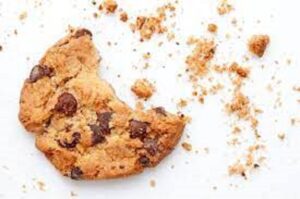Doctor Curmudgeon ® And That’s How the Cookie Crumbles!
By Diane Batshaw Eisman, M.D. FAAP Doctor Eisman is in Family Practice in Aventura, Florida with her partner, Dr. Eugene Eisman, an internist/cardiologist
It took a research team at the Massachusetts Institute of Technology to study the physics of this complex problem.
In my earlier days, I would grab an Oreo cookie and simply ingest it…just the way it was.
But as I became more sophisticated, around the age of six, I discovered that my pleasure was increased by twisting the cookie apart. It was then that my sharp little teeth could scrape off the prized cream filling. And then, and only then could each piece of the wafer be enjoyed separately.
The cream was never evenly distributed on each section, but I simply did not care.
At long last, the Oreo cookie achieved the recognition that it deserves. Since the Oreo first arrived on the scene in 1912, there has been no significant study into the dismemberment of this cookie.
It was a team of MIT scientists that published their research in a peer-reviewed journal,” Physics of Fluids.” They too, were concerned as to why the cream usually sticks to only one side of the cookie. Being a learned group of engineers in the study of how non-Newtonian material will flow when slid or twisted, they went to work on this complicated problem.(Wikipedia discusses a non-Newtonian material: (“A non-Newtonian fluid is a fluid that does not follow Newton’s law of viscosity, that is, it has variable viscosity dependent on stress. In non-Newtonian fluids, viscosity can change when under force to either more liquid or more solid”)
These scientists appropriately titled their research, “Oreology,” As befits a study of this importance, their sample size was appropriate as they tested more than one thousand Oreos.
Since the inner cream is considered a fluid, they used an instrument called a rheometer. Rheometers test the ways in which fluids respond when different kinds of forces are applied.
To be sure that every scientific method was applied in their research, they also did testing by hand.
Many kinds of Oreos were rigorously examined as part of the study and there was no difference between the type of Oreo or amount of cream or flavor of the cream or position in the box.
As Crystal Owens, who was an MIT Ph.D. candidate in mechanical engineering and part of the study group, said, “There was no combination of anything that we could do by hand or in the rheometer that changed anything in our results.”
Crystal Owens concluded that, “As they are now, we found there’s not trick to twisting that would split the cream evenly.”
The research was supported in part, by the MIT UROP program and by the National Defense Science and Engineering Graduate “Fellowship Program
And to those who ask the question, “Why did the researchers at MIT study the breaking apart of Oreo cookies?”…. I respond, “Why not?”
This research may seem trivial, but it is not. By studying the fluid dynamics of the Oreo cookie, this is an important pathway into the principles of complicated fluid dynamics which are essential in complex fields such as 3-D printing.
Dr. Curmudgeon suggests “Bitter Medicine”, Dr. Eugene Eisman’s story of his experiences–from the humorous to the intense—as a young army doctor serving in the Vietnam War.
Bitter Medicine by Eugene H. Eisman, M.D. –on Amazon
Doctor Curmudgeon® is Diane Batshaw Eisman, M.D., a physician-satirist. This column originally appeared on SERMO, the leading global social network for doctors.
SERMO www.sermo.com
Click Here to Order Boxing Interviews Of A Lifetime By “Bad” Brad Berkwitt


